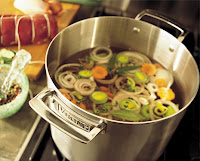
M-F 9:30am – 3:30pm EST
Hello and welcome to a cold, snowy February. The Super Bowl is over and we send out congratulations to the Seahawks on their dominating win.
We thought we would warm you up with some soups and stocks talk, spotlight one of our favorite chefs, and give you a great recipe to make for your Valentine, a delicious Blood Orange Chocolate Mouse.
Family tradition is one of the most beautiful aspects of cooking. Sharing recipes and methods of preparation down through generations, has become one of the most creative ways for home cooks to create a niche for themselves in the kitchen. Talk to most chefs, both acclaimed and not, and they will readily admit somewhere in their r’epertoire is most likely a recipe or number of recipes, derived or adapted from childhood memory or recipes handed down through the family over the years. Some chefs have even made TV careers & businesses from these love filled, time tested recipes. More often than not, one of the staple recipes handed down in most families are soups and stocks.
Stock
 To begin, let’s take the simple definition. Most soups start with some type of broth or stock which is defined as; a liquid (usually water) that is fortified with a definite flavor. Different types of stocks include, vegetable, chicken, beef, duck, fish, lobster, corn, asparagus, etc The list is endless depending on what flavor you are looking for and, of course the ingredients that you are going to use it in. The final flavor you are trying to achieve determines how you are going to treat the ingredients going in. As an example were you to be making corn stock, your flavors would take on a completely different profile if you were using raw corn vs. roasted corn. Developing a base flavor is an important part, if not the most important part, of a successful soup and that can be achieved in many ways. If the home cook wants to make a meaty and rich soup for instance, it is important to caramelize the meat and vegetables first, then deglaze the pan with a liquid (sometimes red or white wine) to remove the flavorful pieces from the bottom of the pan (called fond) and add those flavors to the soup resulting in a richness of flavor called Umami.
To begin, let’s take the simple definition. Most soups start with some type of broth or stock which is defined as; a liquid (usually water) that is fortified with a definite flavor. Different types of stocks include, vegetable, chicken, beef, duck, fish, lobster, corn, asparagus, etc The list is endless depending on what flavor you are looking for and, of course the ingredients that you are going to use it in. The final flavor you are trying to achieve determines how you are going to treat the ingredients going in. As an example were you to be making corn stock, your flavors would take on a completely different profile if you were using raw corn vs. roasted corn. Developing a base flavor is an important part, if not the most important part, of a successful soup and that can be achieved in many ways. If the home cook wants to make a meaty and rich soup for instance, it is important to caramelize the meat and vegetables first, then deglaze the pan with a liquid (sometimes red or white wine) to remove the flavorful pieces from the bottom of the pan (called fond) and add those flavors to the soup resulting in a richness of flavor called Umami.
A French term called ‘Mirepoix,’ is the foundation of most soups and stocks. This is a mixture of 2 parts onion, 1 part carrot, and 1 part celery. Make sure you have a good sharp Chef knife to break them down. Make sure your Aromatics are flavor enhancers that are added to your stock to bloom or boost flavors. Aromatics include: peppercorns, bay leaves, juniper berries, any herbs, any onions, or garlic. Most importantly, we need to determine what type of stock we want to create, and then decide what the future of our beautiful stock will be. After you have added all your ingredients, you are now ready to let your stock simmer. A simmer is a temperature between 190-200 degrees and different stocks have different simmering times in order to reach their fullness of flavor:
Vegetable stocks~45 minutes Fish stocks~1 hour 30 minutes, Chicken (Poultry) stocks~2 hours, Beef stocks~6 hours ( pre-roast the bones)
Once your stock is completely simmered to it’s full richness, the final step is straining it properly. What we are looking for is a pure, smooth and beautiful liquid so at this point we need to pass it through a strainer or “cheesecloth” to remove all impurities and vegetables, or large ingredients. Your stock can now be used immediately, or can be frozen in smaller batches to be thawed and used the next time you decide to make a soup or sauce.
Soup
 Soup is a food that is made by combining ingredients such as meat and vegetables in stock or hot/boiling water, until the flavor is extracted, forming a broth. Traditionally, soups are classified into two broad groups: clear soups and thick soups. The established French classifications of clear soups are bouillon and consommé. Thick soups are classified depending upon the type of thickening agent used: purées are vegetable soups thickened with starch; bisques are made from puréed shellfish thickened with cream; cream soups are thickened with béchamel sauce; veloutes are thickened with eggs, butter and cream.
Soup is a food that is made by combining ingredients such as meat and vegetables in stock or hot/boiling water, until the flavor is extracted, forming a broth. Traditionally, soups are classified into two broad groups: clear soups and thick soups. The established French classifications of clear soups are bouillon and consommé. Thick soups are classified depending upon the type of thickening agent used: purées are vegetable soups thickened with starch; bisques are made from puréed shellfish thickened with cream; cream soups are thickened with béchamel sauce; veloutes are thickened with eggs, butter and cream.
Other ingredients commonly used to thicken soups and broths include rice, flour, and grains and beans. The word soup originates from “sop,” a dish originally consisting of a soup or thick stew which was soaked up with pieces of bread. The modern meaning of sop has been limited to just the bread intended to be dipped.
Cooking with the seasons can be a lot of fun, so when thinking soups and stocks, consider ingredients available at that time of year and enjoy gathering ingredients that are at their peek of freshness. Winter is a great season for soups, so be creative and enjoy!
 In this addition of Chef’s spotlight we’d like to introduce you to Chef & Grillmaster Michael McDearman. Michael is a World Champion GrillMaster and “Live Fire” cooking specialist with numerous publications, TV appearances and host of a new TV show for PBS.
In this addition of Chef’s spotlight we’d like to introduce you to Chef & Grillmaster Michael McDearman. Michael is a World Champion GrillMaster and “Live Fire” cooking specialist with numerous publications, TV appearances and host of a new TV show for PBS.
Eager and an entrepreneur since an early age, Michael wanted a motorcycle. Asking his parents for one proved to be a lesson in being goal oriented. They taught him to earn the money to pay for his own desires. So Michael became the youngest paperboy in his hometown. Why is this important? It’s the beginning of his “smoke ring or his BBQ beginning.”
While on his route, Michael found himself consistently slowing down and breathing deeper at one particular house. Being a curious kid, he approached the neighbor and asked “Whatcha doin’?” The man took the time to share with Michael what he was doing: he was a competition BBQ cook. And so it began. By the time Michael was eight years old, he was finishing meals for his parents when they came home from work.
After 35 years of cooking experience and pre-Internet mentoring under his Grandmother (who has been published more times in Southern Living than she has fingers or toes), as well as many other influences (USA and International), Michael has received rave reviews and bold testimonials about his cooking from the salt of the earth red, white and blue Americans to Blue-Blood British Lords. He has performed his live fire cooking on some of the largest cooking stages in BBQ and Grilling: The World Food Championships in Las Vegas, The “Jack” Jack Daniels Invitational BBQ Championships, The Sam’s Club National BBQ Tour, and the Academy of Country Music Awards BBQ Throwdown. Michael represents many companies in BBQ, such as “Beef. It’s What’s For Dinner.,” Heinz, McCormick Spices, Coke, Bull Outdoor Products, E-Z Hook, FoodEnquirer.com, and MojoBricks to spread the word about the benefits of using their products while cooking over a live fire.
Watch his audition tape for BBQ Pitmasters & learn more interesting facts about Grillmaster Michael McDearman.
Here he is using his Ergo Chef Chef’s Knife
You can find Michael on twitter at @GetFiredUpFoods and visit his website here:

If you love to grill check out these Ergo Chef must have 15″ DUO Tongs that grip anything and can pick up to 20lbs of product without bending. See coupon code below to save.
 Last but not least, in honor of Valentine’s Day, we have a great recipe for you to make for your sweetie. Decadent Chocolate Mousse infused with Blood Orange and a touch of orange liquor, designed to tantalize your taste buds and get you and your Valentine in the mood for some romance.
Last but not least, in honor of Valentine’s Day, we have a great recipe for you to make for your sweetie. Decadent Chocolate Mousse infused with Blood Orange and a touch of orange liquor, designed to tantalize your taste buds and get you and your Valentine in the mood for some romance.
Dark Chocolate Blood Orange Mousse
Enjoy,
Ergo Chef

Natoque viverra porttitor volutpat penatibus himenaeos. Vehicula commodo si hendrerit.



